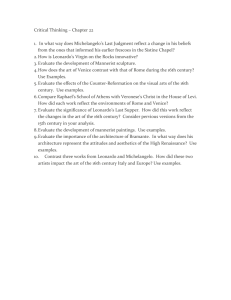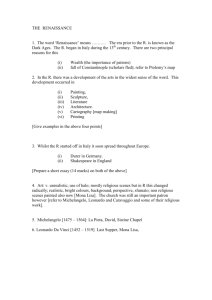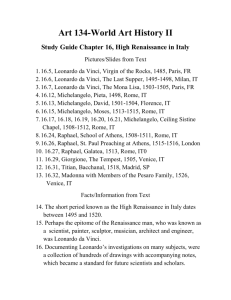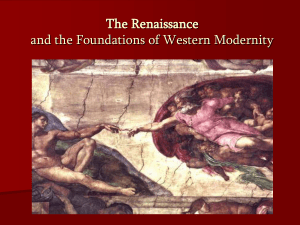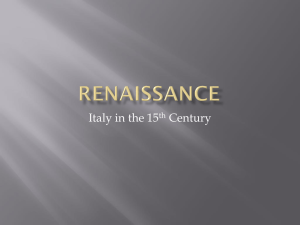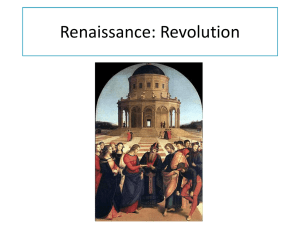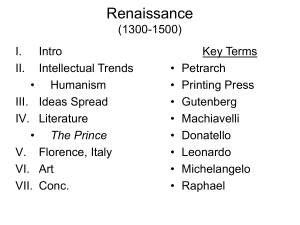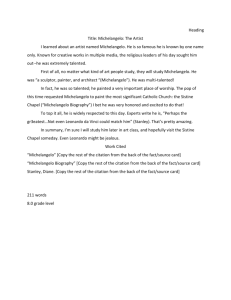AH2 2011 Ch. 20 notes (06-10-11).doc
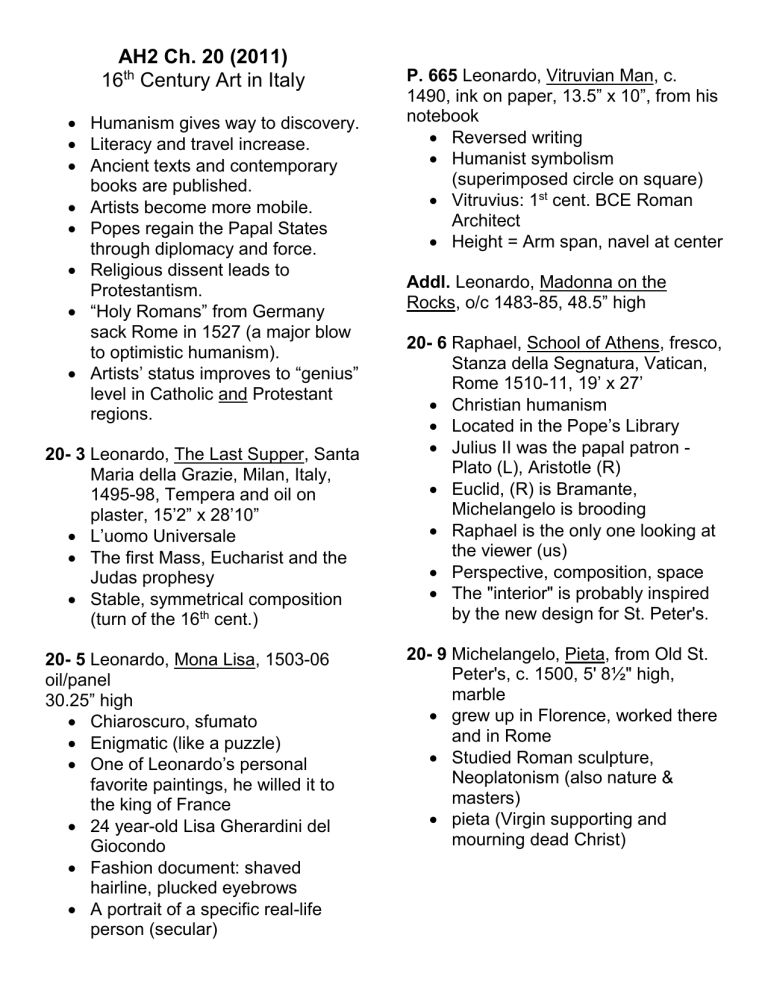
AH2 Ch. 20 (2011)
16
th
Century Art in Italy
Humanism gives way to discovery.
Literacy and travel increase.
Ancient texts and contemporary books are published.
Artists become more mobile.
Popes regain the Papal States through diplomacy and force.
Religious dissent leads to
Protestantism.
“Holy Romans” from Germany sack Rome in 1527 (a major blow to optimistic humanism).
Artists’ status improves to “genius” level in Catholic and Protestant regions.
20- 3 Leonardo, The Last Supper, Santa
Maria della Grazie, Milan, Italy,
1495-98, Tempera and oil on plaster, 15’2” x 28’10”
L’uomo Universale
The first Mass, Eucharist and the
Judas prophesy
Stable, symmetrical composition
(turn of the 16 th cent.)
20- 5 Leonardo, Mona Lisa, 1503-06 oil/panel
30.25” high
Chiaroscuro, sfumato
Enigmatic (like a puzzle)
One of Leonardo’s personal favorite paintings, he willed it to the king of France
24 year-old Lisa Gherardini del
Giocondo
Fashion document: shaved hairline, plucked eyebrows
A portrait of a specific real-life person (secular)
P. 665 Leonardo, Vitruvian Man, c.
1490, ink on paper, 13.5” x 10”, from his notebook
Reversed writing
Humanist symbolism
(superimposed circle on square)
Vitruvius: 1 st cent. BCE Roman
Architect
Height = Arm span, navel at center
Addl.
Leonardo, Madonna on the
Rocks, o/c 148385, 48.5” high
20- 6 Raphael, School of Athens, fresco,
Stanza della Segnatura, Vatican,
Rome 151011, 19’ x 27’
Christian humanism
Located in the Pope’s Library
Julius II was the papal patron -
Plato (L), Aristotle (R)
Euclid, (R) is Bramante,
Michelangelo is brooding
Raphael is the only one looking at the viewer (us)
Perspective, composition, space
The "interior" is probably inspired by the new design for St. Peter's.
20- 9 Michelangelo, Pieta, from Old St.
Peter's, c. 1500, 5' 8 ½" high, marble
grew up in Florence, worked there and in Rome
Studied Roman sculpture,
Neoplatonism (also nature & masters)
pieta (Virgin supporting and mourning dead Christ)
20-10 Michelangelo, David, 1501-04, marble 17’ high
Made for the Florence town hall
(Palazzo Vecchio)
Carved from an 18' block " Il gigante "
he thought the idea was "locked in the stone"
Potential energy, Christian humanism, emotional
symbolic, beauty = divinity
(humanism)
20- 11, 12 and 13 Michelangelo (and others), Sistine Chapel Frescoes, (built
1475- 81, frescos: ceiling 1508-12, end wall 1536-41)
The Last Judgement, The creation of Adam
Christian redemptive cycle: birth, death, rebirth in heaven
sin & forgiveness
almost 6000 sq. ft. by
Michelangelo
------------------------------------------------------
Art of the Western World – The High
Renaissance Video Part I ends and part
2 begins here (Program 4) http://www.learner.org/resources/series1.html?pop=yes&vodid=429878&pid=231
------------------------------------------------------ p. 651
» Old St. Peters, 4 th Cent.
Bramante, Plan for New St. Peter's,
1506
Michelangelo, Plan for New St.
Peter's, 1546-64
Maderno, Plan for New St. Peter's,
1607-12
Addl.
Renaissance palace façade & courtyard, 1517-50
Palazzo Farnese, Rome
20-21 Giorgione, The Tempest, Venice,
1506, o/c. 32" high
He introduced an appreciation of nature to Venetian painting.
“maternal” not “erotic” nudity
The landscapes dominates the painted surface.
Enigmatic, German mercenary?, woman breast feeding?, bad weather?
Giorgione died from the plague.
20- 22 Titian & Giorgione, The Pastoral
Concert, o/c, c. 1510, 41.25
” high
Idyllic, fertile landscape (as in T he
Tempest )
A mythic world
The aristocratic musician in red silks and the barefoot peasant man both ignore the sensual women.
Evocative of Roman pastoral poetry (nothing happens) – new to
Art History
Profoundly influential on later painters
20- 23 Titian, Pesaro Madonna, 1519-
26, oil on canvas (o/c), 16’ × 8'10"
Official painter to Venetian Republic after Bellini's death in 1516
Asymmetrical and dynamic, "public relations"
Flag w/ "arms" of the pope and the
Pesaros
A Turkish captive reminds us of the
Christian victory, Jacopo Pesaro commanded the Papal fleet
Pesaro family members at the lower right
Trompe l’oeil illusion, Christian humanism
Addl.
Michelangelo, Piazza del
Campidoglio, Rome, c. 1538-64 substitute: Façade of Palazzo de
Conservatori, Capitoline Hill
an urban-renewal project patronized by Pope Paul III
segmental pediments, pilasters, statuary, engaged columns, giant order columns, star designed piazza
20-36 Vignola & della Porta, Façade of Il
Gesù, c. 1573-84
Ignatius Loyola's capitol of the
Jesuits (Catholic Missionaries)
Classically inspired with new verticality and centrality
Seminal design for the next century
paired "colossal" pilasters tie the two stories together (verticality)
part of the counter-reformation program of church building
20-26 Pontormo, Entombment, 1525-28, o/p, 10' 3" high altarpiece, Capponi
Chapel, Church of Santa Felicità,
Florence
Mannerism = virtuous, sophisticated, elegant compositions, distorted conventions, irrational space and scale, elongations, exaggerations, enigmatic gestures, erotic images, unusual colors,strange secondary symbolism and lots of flesh
20- 27 Parmigianino, Madonna with the
Long Neck, c. 1534-40, o/p, 7' 1" high
part of the Counter-Reformation art program
20- 32 Benevenuto Cellini,
Saltcellar of Francis I, 1540-43, Gold with enamel, 10¼" high
A Florentine in Fountainbleau
Francis I (King of France) was the greatest French patron of Italian artists
Charles V (Holy Roman Emperor) was his brother-in-law
The Reformation (a Christian schism, or split, of Western European
Christianity)
denied the Pope's authority and challenged church teaching
many powerful rulers supported the
Reformation
Early reformers were themselves
Catholic priests: Erasmus of
Rotterdam and Martin Luther in
Germany
Luther discounted the seven sacraments (Baptism, Confirmation,
Eucharist, Penance, Extreme Unction or Anointing of the Sick, the Holy
Orders, Matrimony, and the Last
Things). He said faith alone is all you need to get to heaven (salvation).
Protestantism prevailed in northern
Europe
Lots of religious art was destroyed by
Protestant hands.
Protestants still used music, however!
The Catholic "Council of Trent"
(1545-63) begins the "counterreformation" (art to be used, but scrutinized!)
The printing press and movable type fueled the Reformation!
20- 16 Donato Bramante, Tempietto,
Rome 1502-10, dome & lantern redone
17 th cent.
Commissioned by Queen Isabella
& King Ferdinand of Spain to mark
St. Peter's place of crucifixion, inspired by Vitruvius and Alberti
Page 671 Veronese, Feast in the House of Levi, Dominican Monastery, Venice,
1573, o/c, 18' 3" high
Great illusion, originally a last supper scene
he was forced to change the image's details
he changed its name - unprecedented artistic license
20- 37 Jacopo Tintoretto, The Last
Supper,1592-94, o/c, Giorgio San
Maggione, Venice, 12' high
night scene, artificial and divine light
anecdotal, phantasmagoric, genre scene (Venetian banquet) - draws us in
collaborative workshop production of paintings
he used small scale wax figures &
"stage" as a model
20- 40 Palladio, Villa Rotunda (Capra),
Vicenza Italy, begun 1560s
based on the Roman Pantheon
a country villa (retreat)
geometric clarity
circle in a square: humanist symbol
he wrote "Four Books on
Architecture" his theories are seminal
Thomas Jefferson's favorite! (hence the US Federal style)
Palladian windows - Have you heard of them?
20-41 Plan c.1550, His writings were collected widely by 18 th century educated people. Thomas Jefferson (c.
1770) had one of the first copies in
America. He was a fan of Palladio’s theories.
